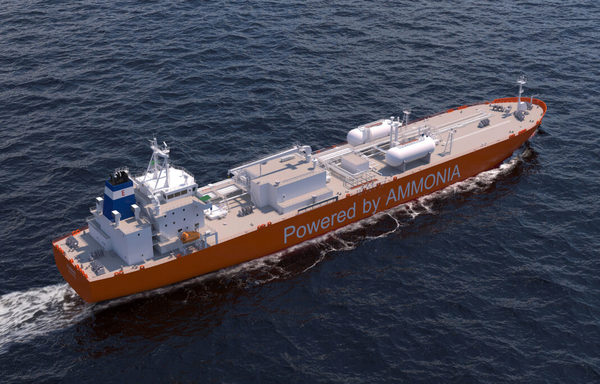More EXMAR newbuilds will use Wärtsilä ammonia equipment
Finnish OEM Wärtsilä will provide ammonia fuel supply and cargo handling systems for two more of EXMAR’s upcoming ammonia-fuelled gas carriers.
 PHOTO: Concept design of EXMAR's ammonia-fuelled gas carrier. Wärtsilä
PHOTO: Concept design of EXMAR's ammonia-fuelled gas carrier. Wärtsilä
South Korea’s Hyundai Mipo Dockyards is constructing a total of six ammonia-fuelled gas carriers for Exmar LPG. Exmar LPG is a joint venture between the Belgian shipping company Exmar and LNG-vessel operator Seapeak.
Four of these vessels have already been ordered to be equipped with Wärtsilä’s ammonia equipment. With the latest order, all six vessels will now feature Wärtsilä’s ammonia fuel supply and cargo handling systems tailored for propulsion.
“Operating with ammonia has the potential to significantly reduce greenhouse gas emissions when compared to conventional marine diesel fuel, as ammonia doesn’t produce CO2, sulphur or particulate emissions when combusted,” Wärtsilä said.
The systems are scheduled to be delivered to the shipyard by next year.
Fuelling ships with ammonia
Wärtsilä’s technology is an integrated cargo handling and fuel supply system designed for 2-stroke engines that use liquid ammonia as a marine fuel. It is intended for ships carrying liquefied gas as cargo.
In the case of gas carriers, ammonia can be reloaded on the vessels from the cargo tanks instead of using dedicated bunkering lines, the company said.
The fuel supply system is equipped with a purge gas treatment system. Purging is the process of removing residual gases from fuel lines, tanks, and other components where the gas has accumulated. In this case, it is to prevent the accumulation of ammonia in fuel supply systems.
Purge gas treatments are typically done using nitrogen. An injection of nitrogen is used to flush out any remaining fuel in the fuel piping, a process known as nitrogen purging. Since nitrogen is an inert gas, it helps stabilize the pipeline environment and reduces the risk of safety incidents.
Since ammonia is a hazardous and toxic substance by nature, the engine features an additional safety measure known as an "ammonia release mitigation system.” Wärtsilä explains that this system breaks down ammonia emissions into nitrogen and water, significantly reducing ammonia emissions to less than 30 parts per million (ppm).
“Due to the need for high cleanness of the fuel, proper filtering upstream is installed and embedded in the system,” Wärtsilä added.
By Konica Bhatt
Please get in touch with comments or additional info to news@engine.online





